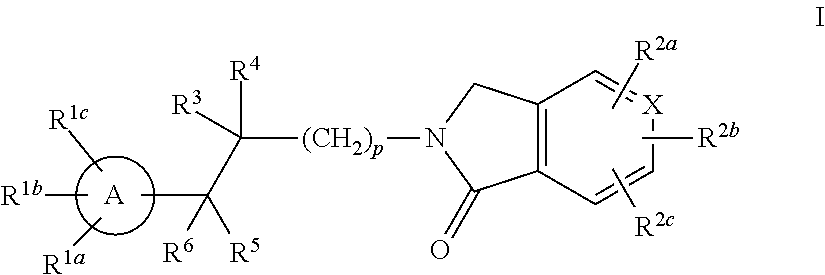Isoindoline pde10 inhibitors
a technology of isoindoline and pde10, which is applied in the field of compounds, can solve the problems of high non-compliance or discontinuation rate of medication, lack of efficacy, and dissatisfaction with therapy
- Summary
- Abstract
- Description
- Claims
- Application Information
AI Technical Summary
Benefits of technology
Problems solved by technology
Method used
Image
Examples
example 1
[0211]
tert-butyl {2-[3-(4-methoxyphenyl)-4-oxo-3,4-dihydroquinazolin-2-yl]ethyl}carbamate (A-1)
[0212]A slurry of 2-aminonicotinic acid (2 g, 14.48 mmol), Boc-beta-Ala-OH (2.76 g, 14.58 mmol) and triphenyl phosphite (4.17 ml, 15.93 mmol) in pyridine (30 ml) was heated at 100° C. for 6 hours. The initial slurry became a clear solution. To the reaction mixture was added p-anisidine (1.962 g, 15.93 mmol) and heating was continued for 16 hours. The resulting reaction mixture was concentrated to dryness and the resulting oil was partitioned between saturated aqueous sodium carbonate solution (100 mL) and ethyl acetate (100 mL). The aqueous layer was washed with ethyl acetate and the combined organic layers were concentrated to dryness. The resulting oil was dissolved in dichloromethane (10 mL) and loaded onto a silica gel column and eluted with a gradient of 0-100% ethyl acetate in hexanes over 33 min to provide 4 g, (70%) of A-1 as a brown solid. LC / MS: rt=1.20 min; m / z=396.4 (MH+).
2-(2-...
example 2
[0216]
tert-butyl 3-(4-hydroxy-1,3-dioxo-1,3-dihydro-2H-isoindol-2-yl)propanoate (B-2)
[0217]B-1 (2.0 g, 11.01 mmol) and 3-hydroxyphthalic anhydride (1.9 g, 11.56 mmol) were suspended in dioxane (10 mL). TEA (4.6 mL, 33 mmol) was added to the suspension and heated to 50° C. overnight. After cooling, the solution was diluted with EtOAc (150 mL), washed with water (100 mL) and concentrated brine (100 mL). The organic layer was dried over Na2SO4 and concentrated to provide B-2 (2.1 g, 65.5% yield) as an off-white solid.
tert-butyl 3-(4-isopropoxy-1,3-dioxo-1,3-dihydro-2H-isoindol-2-yl)propanoate (B-3)
[0218]B-2 (1 g, 3.43 mmol) was suspended in acetonitrile (25 ml) in a sealed tube. While stirring, 2-iodopropane (687 μL, 6.87 mmol) and cesium carbonate (3.36 g, 10.30 mmol) were added. The tube was capped and heated to 80° C. for 4 hours. After cooling to room temperature, the reaction was diluted with EtOAc (150 mL) and washed with water (100 mL) and concentrated brine (100 mL). The organi...
example 3
[0222]
2-chloro-3-(4-methoxyphenyl)quinoline (C-1)
[0223]To a suspension of 3-iodo-2-chloroquinoline (600 mg, 2.1 mmol) and 4-methoxyphenylboronic acid (346 mg, 2.28 mmol) in 25 mL toluene was added 2M Na2CO3 (2.1 mL, 4.2 mmol) and tetrakistriphenylphosphinepalladium(0) (120 mg, 0.1 mmol). After heating in an oil bath at 75° C. for 36 h, the reaction was partitioned between EtOAc and water, separated, and the organic was washed with water, dried over Na2SO4 and concentration by rotary evaporation. The residue was purified by silica gel chromatography (hexanes / EtOAc) to provide C-1 (230 mg, 41%) as a pale yellow solid. LC / MS: rt=1.41 min; m / z (M+H)=270.1.
tert-butyl {2-[3-(4-methoxyphenyl)quinolin-2-yl]ethyl}carbamate (C-2)
[0224]In a 1 dram vial under nitrogen was mixed Pd(OAc)2 (38 mg, 0.17 mmol) and di(1-adamantyl)-n-butylphosphine (64 mg, 0.17 mmol) in 1 mL toluene and the mixture was allowed to stir for 5 minutes. To a separate flask was added C-1 (230 mg, 0.85 mmol), potassium tert...
PUM
| Property | Measurement | Unit |
|---|---|---|
| catalytic domain homology | aaaaa | aaaaa |
| PKA | aaaaa | aaaaa |
| enantiomers | aaaaa | aaaaa |
Abstract
Description
Claims
Application Information
 Login to View More
Login to View More - R&D
- Intellectual Property
- Life Sciences
- Materials
- Tech Scout
- Unparalleled Data Quality
- Higher Quality Content
- 60% Fewer Hallucinations
Browse by: Latest US Patents, China's latest patents, Technical Efficacy Thesaurus, Application Domain, Technology Topic, Popular Technical Reports.
© 2025 PatSnap. All rights reserved.Legal|Privacy policy|Modern Slavery Act Transparency Statement|Sitemap|About US| Contact US: help@patsnap.com



